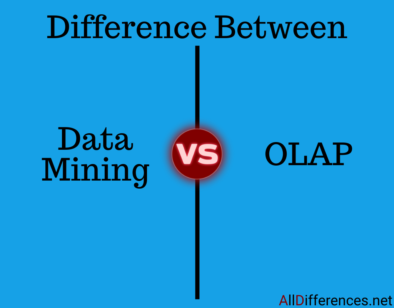Comparison between Data Mining and OLAP
Contents
- The Key Difference Between Data Mining and OLAP is that Data mining is the process of extracting knowledge from data, while OLAP(Online analytical Processing) is the process of analyzing data to answer specific questions.

Comparison Chart
- Here is a table that summarizes the key differences between data mining and OLAP:
| Data Mining | OLAP |
|---|---|
| Used for future data prediction | Used for analyzing past data. |
| Extract knowledge from data | Answer specific questions |
| Top-down Approach | Bottom-up Approach |
| Large, complex data sets | Smaller, more structured data sets |
| Statistical analysis, machine learning, artificial intelligence | Databases, data warehouses, data marts |
Data Mining: Unveiling Hidden Patterns
What is Data Mining?
Data mining is a process of discovering hidden patterns, relationships, and trends within vast amounts of data. It involves the use of sophisticated algorithms and statistical techniques to extract valuable insights from structured, semi-structured, and unstructured data sources. By analyzing historical data, data mining enables organizations to identify patterns that can guide decision-making, predict future outcomes, and optimize various business processes.
Key Features and Techniques
Data mining encompasses a wide range of techniques, including:
- Association Rule Mining: Identifying relationships and dependencies between variables.
- Classification: Categorizing data into predefined classes or groups based on specific attributes.
- Clustering: Grouping similar data points together based on their characteristics.
- Regression Analysis: Predicting numerical values based on historical data patterns.
- Text Mining: Extracting valuable information from textual data sources.
- Time Series Analysis: Analyzing data points collected over a specific period to identify patterns or trends.
Use Cases of Data Mining
Data mining finds applications in various domains, such as:
- Retail: Analyzing customer purchasing patterns and predicting future buying behavior.
- Finance: Detecting fraudulent activities and identifying potential market trends.
- Healthcare: Analyzing patient records to predict disease patterns and optimize treatment plans.
- Marketing: Segmenting customers based on their preferences for targeted campaigns.
- Manufacturing: Optimizing production processes and predicting equipment failure.
Data mining is often used to identify patterns and trends in data that would not be visible to the naked eye. This information can then be used to make predictions about future events, improve decision-making, or identify new opportunities.
OLAP is used to answer specific questions about data. This can be done by slicing and dicing the data, or by drilling down into the data to get more detail. OLAP can be used to answer questions about sales, customer behavior, inventory levels, and more.
Data mining and OLAP are both powerful tools that can be used to gain insights from data. However, they are different tools that are used for different purposes. Data mining is used to extract knowledge from data, while OLAP is used to answer specific questions.
OLAP: Multidimensional Analysis
What is OLAP?
OLAP, or Online Analytical Processing, is a technology that enables users to perform complex multidimensional analysis on large datasets in real-time. It allows for interactive exploration of data from multiple dimensions, providing a holistic view of business operations. OLAP systems are designed to facilitate ad-hoc queries, drill-downs, and data aggregations, empowering decision-makers to gain actionable insights from different perspectives.
Key Features and Components
OLAP systems typically consist of the following components:
- Cubes: Multidimensional data structures that organize data hierarchically.
- Dimensions: Descriptive attributes that define the structure of the data.
- Measures: Quantitative data values that are analyzed and aggregated.
- Hierarchies: Organizational structures that allow for drill-down and roll-up operations.
- Aggregations: Precomputed summary data for faster query response times.
- MDX (Multidimensional Expressions): A query language for OLAP systems.
Use Cases of OLAP
OLAP technology is employed in various scenarios, such as:
- Financial Analysis: Examining financial data from different perspectives to identify trends and make informed decisions.
- Sales Analysis: Analyzing sales data across various dimensions to evaluate product performance and identify opportunities for growth.
- Supply Chain Management: Monitoring inventory levels, logistics, and procurement processes to optimize supply chain operations.
- Customer Relationship Management: Analyzing customer data to gain insights into purchasing patterns, preferences, and behaviors.
- Business Performance Management: Evaluating key performance indicators (KPIs) and monitoring organizational goals.
